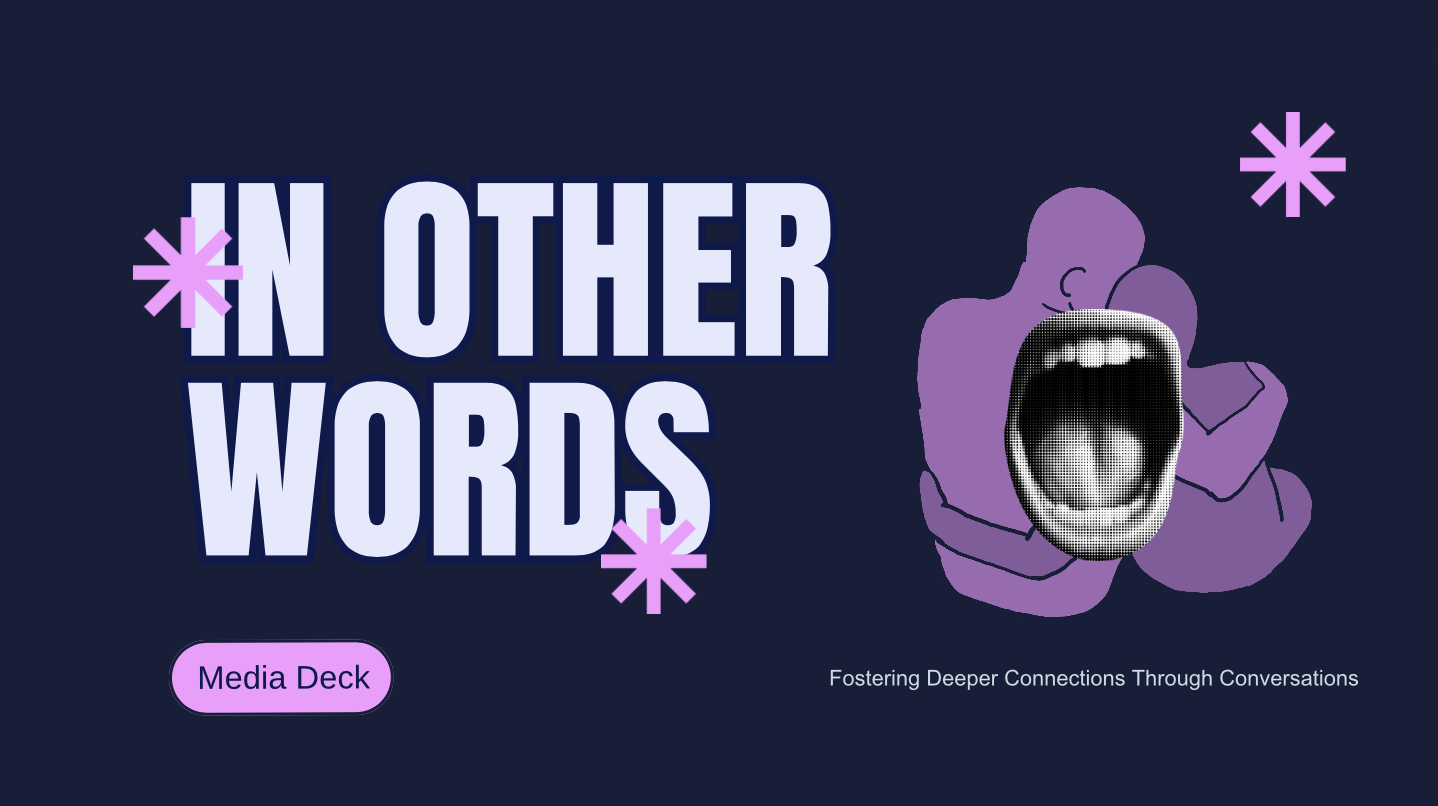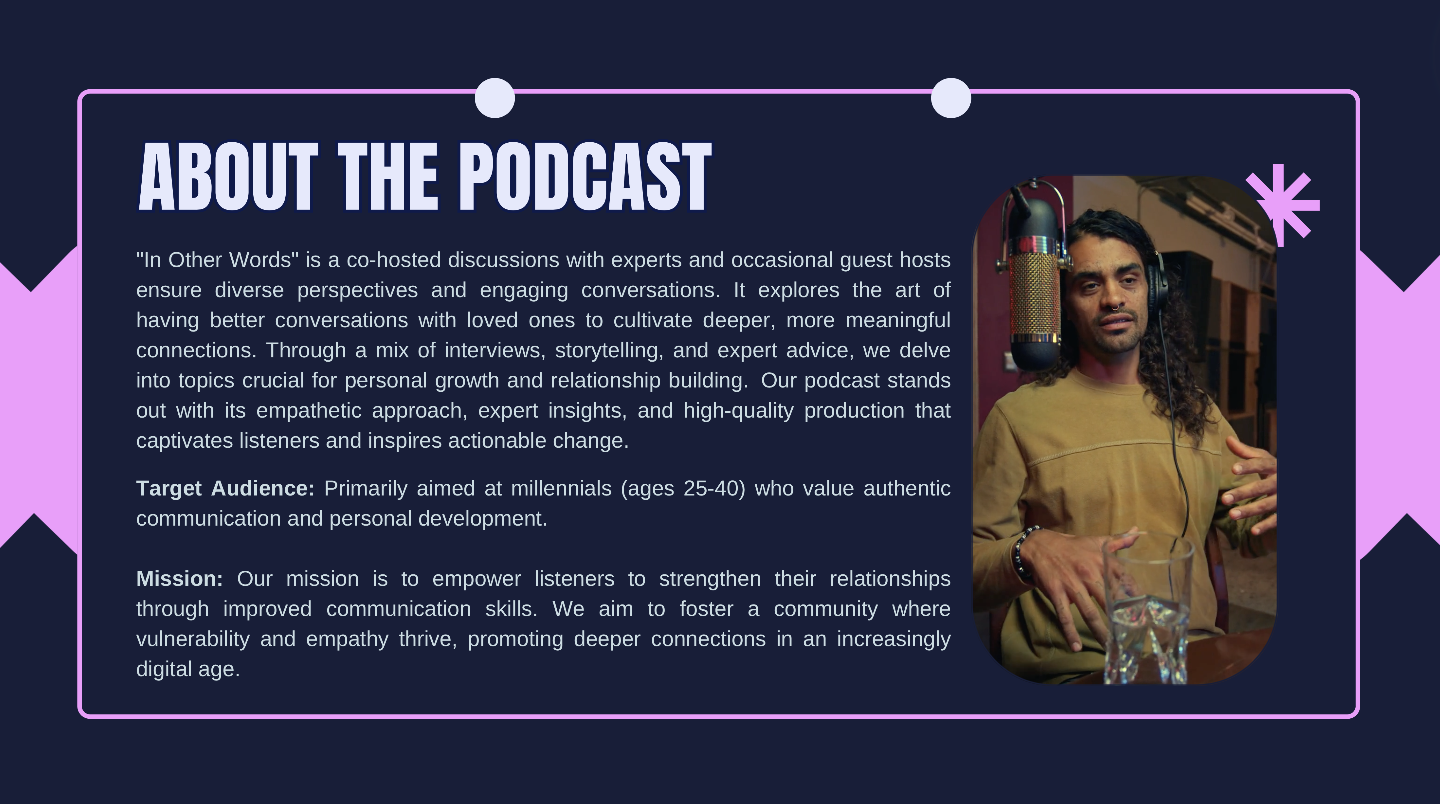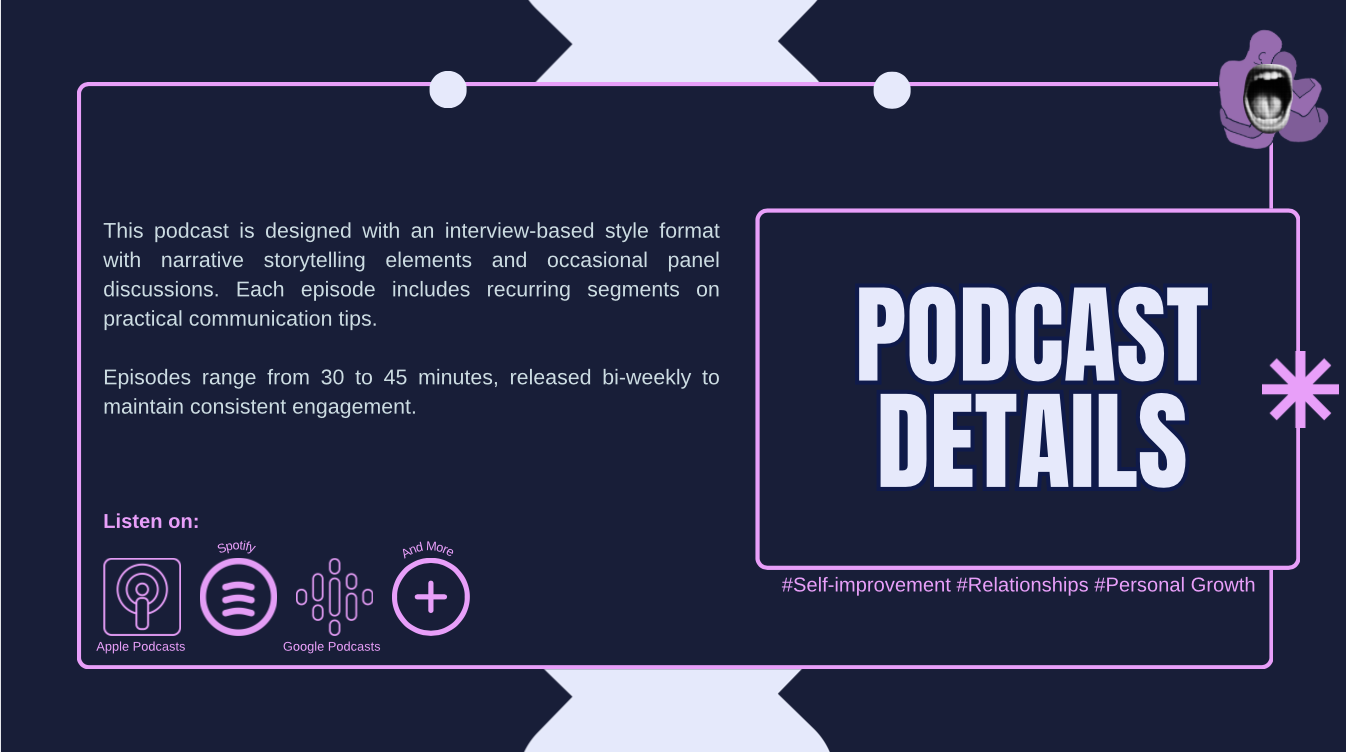Media Guide: How to Create a Media Kit for Your New Podcast to Attract Collaborators and Brands
Jul 2024
Introduction
Creating a media kit for a new podcast is an essential step in attracting collaborators, brands, and audiences. It can help present your podcast professionally and provide potential partners with the necessary information to understand your podcast’s value. Here’s a step-by-step guide to help you create an effective media kit.
Start by Defining Your Podcast's Identity
You will use the answers to the following questions throughout a few vital sections of the Podcast. Copy and paste the following sections and craft your answers on a text management tool like Microsoft Word, Google’s Docs or Notes on your phone. Whichever is most comfortable for you to get started. Nothing has to be perfect, just write.
To Craft Your Mission Statement
What is the core purpose of your podcast?
What message or value are you delivering to your audience?
What makes your podcast unique?
Define Your Unique Selling Proposition (USP)
Highlight what sets your podcast apart from others in the same niche.
This could be the unique topics you cover, the perspectives you offer, or the format of your episodes.
Who are your competitors and what can you learn from them? Analyzing similar podcasts can provide insights into effective strategies and potential gaps in the market.
Target Audience
Who is your podcast intended for?
Consider demographics (age, gender, location) and psychographics (interests, values, behaviors).
Consider
The tone and style of your podcast. Is it formal, casual, educational, or entertaining?
The main themes or topics covered. Are they consistent with your brand's mission?
Feedback have you received from your audience or trusted peers? Feedback can help refine your content and improve your branding.
Components of a Stellar Media Kit
Introduction and Overview
Podcast Name and Logo: Clear and recognizable branding elements.
Mission Statement and Background: Briefly describe the podcast's purpose and origin story.
Host Information
Bios and Photos: Include professional bios and high-quality photos of the hosts to build a personal connection.
Podcast Details
Launch Date: Mention when the podcast started or the planned launch date if it’s new.
Format and Frequency: Describe the structure of your episodes and how often they are released.
Platform Availability: List all platforms where the podcast can be accessed (e.g., Apple Podcasts, Spotify).
Audience Metrics
Demographics and Psychographics: Detailed information about your listeners.
Download Numbers and Growth Trends: Showcasing your podcast's growth and engagement statistics.
Testimonials and Reviews
Listener Feedback: Positive reviews and testimonials from your audience.
Media Mentions: Any press coverage or notable mentions in the media.
Sponsorship and Collaboration Opportunities
Ad Formats and Rates: Clear information about available sponsorship packages and pricing.
Benefits for Sponsors: Highlight the advantages of collaborating with your podcast.
Visual Elements
High-Quality Graphics and Images: Consistent use of visual branding elements.
Links to Episodes and Social Media: Direct links to your podcast and social media profiles.
Use icons or logos associated with each platform to visually represent where your podcast can be found.
Keep the slide design clean and structured for easy readability, using bullet points or concise sentences to convey each detail.
Include Downloadable Links
Make sure any graphics or headshots are easy to download by providing links or embedding them within the PDF. Consider attaching a link to download the media kit if you’ve created it on Canva and plan to share the view only link with new prospects.
Example Structure for Your Media Kit
Slide 1: Cover Page
Logo
Podcast Name
Tagline
Slide 2: About the Podcast
Description: Describe what topics your podcast covers. Is it interviews, storytelling, news, advice, or a combination?
Target Audience: Who is your podcast for? Specify demographics (age, gender, interests) and psychographics (values, lifestyle).
Unique Selling Points: Highlight what sets your podcast apart. Is it your style, expertise, approach, or production quality?
Mission: Clearly state the reason your podcast exists. What do you aim to achieve with your content? Outline your short-term and long-term goals for the podcast. This could include audience growth, community engagement, or industry recognition.
Hosts: Mention if it's solo-hosted, co-hosted, panel discussions, etc.
Slide 3: Podcast Details
Genre: Clearly define the genre or genres your podcast falls under. Is it entertainment, education, news, storytelling, or a niche category like true crime or self-improvement? Briefly explain how your content fits within this genre to give potential partners a clear understanding.
Format: Describe the format of your podcast. Is it interview-based, narrative storytelling, roundtable discussions, or a mix? Mention any recurring segments or special features that define your format and keep listeners engaged.
Length and Frequency: Specify the average length of your episodes and how frequently new episodes are released. For example, episodes may range from 20 to 60 minutes, released weekly, bi-weekly, or as seasons.
Platforms: List the platforms where your podcast is available for streaming or download. Include popular platforms like Apple Podcasts, Spotify, Google Podcasts, and any others relevant to your audience. Mention if your podcast is accessible on your website or other media channels.
Slide 4: Audience Demographics
Target Audience: Define who your podcast aims to reach. Consider factors such as interests, professions, hobbies, and lifestyle preferences that align with your podcast content.
Describe the psychographics (values, attitudes, behaviors) of your target audience, even if based on assumptions or research.
Highlight any niche interests or specific needs your podcast intends to fulfill.
Demographics: Outline the demographics you expect to attract based on your content, target audience profile, and market research and trends. Include age range, gender breakdown, geographic location (if applicable), education level, and any other relevant demographic information.
Listener Stats: If you haven't launched, provide anticipated listener statistics based on research or industry standards. For example, projected audience size, anticipated growth rate, or engagement metrics.
Slide 5: Episode Highlights
Popular Episodes
Guest Profiles
If you haven't filmed all the episodes of your podcast yet, you can still create an engaging "Episode Highlights" section in your media kit by focusing on the planned content and potential guest profiles.
Focus on Value: Emphasize the value and insights that your upcoming episodes and guests will provide to the audience.
Keep it Engaging: Use compelling language and highlight the most interesting aspects to keep potential listeners intrigued.
Be Transparent: Clearly indicate that these are upcoming episodes and guest profiles to set the right expectations.
Slide 6: Testimonials and Reviews
Listener Reviews
Endorsements
If you haven’t had any listeners just yet, you can use social media comments to create testimonials and reviews for your podcast, even before it officially launches and gathers real listener feedback. Here’s how you can approach it:
Select positive comments > Ask for permission > Attribute them properly to the original poster > Edit for clarity > use it across platforms and in your deck.
Slide 7: Sponsorship Opportunities
Ad Formats: Describe the types of advertising formats available within your podcast. This could include pre-roll ads (before the main content), mid-roll ads (during the episode), post-roll ads (after the episode), sponsored segments, product placements, or endorsements. Highlight the benefits of each ad format in terms of visibility, engagement, and audience interaction.
Rates: Clearly outline your sponsorship rates for each ad format. Include pricing options for different placement lengths (e.g., 15 seconds, 30 seconds, 60 seconds) or sponsorship packages (e.g., per episode, per month). Consider offering tiered pricing based on placement prominence or episode popularity to accommodate different sponsor budgets.
Benefits: Articulate the benefits of sponsoring your podcast. Highlight your audience demographics and anticipated reach, emphasizing how sponsors can connect with a targeted and engaged audience.
Mention additional perks such as social media mentions, website promotion, or inclusion in promotional materials related to your podcast.
Quantify the potential return on investment (ROI) sponsors can expect in terms of brand visibility, lead generation, or customer acquisition.
Slide 8: Contact Information
Email: Provide a direct email address for sponsorship, collaboration or media inquiries
Social Media: List handles for platforms like Twitter, LinkedIn, or Instagram
Website: Include a clickable link to your podcast's website or landing page.
Ensure each detail is clear and easily accessible to facilitate quick and effective contact from potential sponsors or collaborators.
Attracting Collaborators, Brands, and Audiences
Identify Your Goals
Collaborators: Focus on showcasing your podcast's potential for interesting guest interviews and partnerships.
Brands: Emphasize the reach and engagement of your audience, and how it aligns with the brand's target market.
Audience: Highlight the value and entertainment your podcast provides, encouraging listeners to subscribe and share.
Resources to Create Buzz
Social Media: Leverage platforms like Twitter, Instagram, and Facebook to promote your episodes and engage with your audience.
Email Marketing: Use newsletters to keep your subscribers informed about new episodes, behind-the-scenes content, and special announcements.
Podcast Directories and Communities: List your podcast on popular directories and engage in podcasting communities to increase visibility.
Collaborations and Cross-Promotions: Partner with other podcasters or influencers to reach a wider audience.
Conclusion
Creating a media kit for your podcast is a powerful step toward attracting collaborators and brands. It can showcase your podcast’s unique value, build credibility, and open doors to sponsorship opportunities. By clearly defining your podcast's identity, audience, and potential for growth, you're taking a powerful step to position yourself for success. A well-crafted media kit not only highlights your achievements but also demonstrates your commitment and professionalism. This journey, though demanding, can significantly elevate your podcast, connecting you with valuable partners and expanding your reach.











